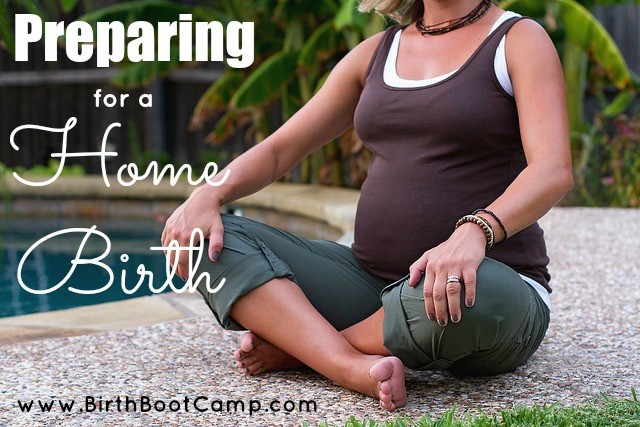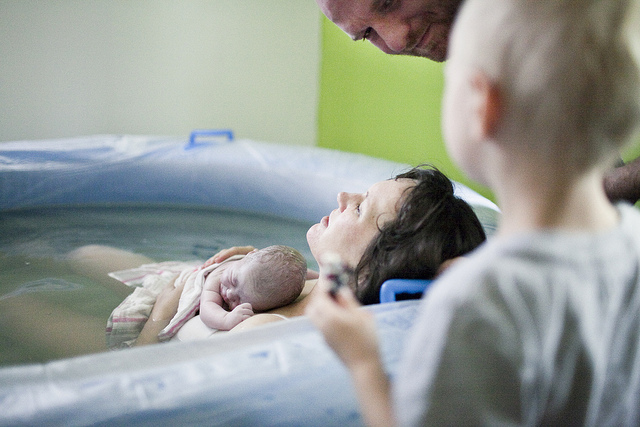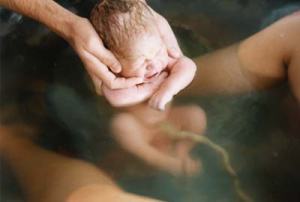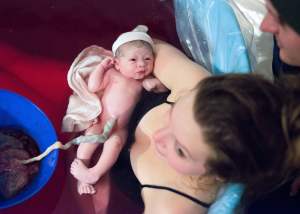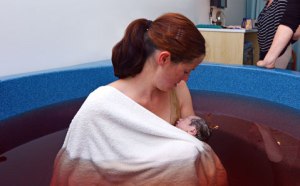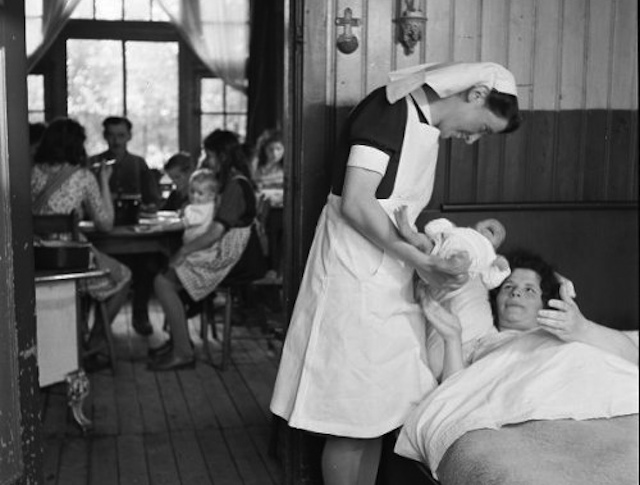“Once a Cesarean, always a Cesarean” has been the standard recommendation for many years. But the increasingly high cesarean section (C-section) rates around the world have led doctors to reassess the risks of a cesarean section versus delivering vaginally after having a previous C-section.
Repeat C-section or VBAC? The answer is not straightforward. Both options do come with some risks, and those risks vary depending on the woman and the specific pregnancy.
Here’s what you need to know about a vaginal birth after cesarean section and what you should discuss with your doctor if you want to try delivering your next baby vaginally.
 1) What is a vaginal birth after cesarean delivery (VBAC)?
1) What is a vaginal birth after cesarean delivery (VBAC)?
If you’re pregnant again and your last baby was born via cesarean section, this time you have two choices about how to give birth:
- an elective repeat caesarean section (ERCS), or
- a VBAC. “VBAC” stands for “vaginal birth after cesarean” and refers to giving birth through the vagina after a woman has already had a C-section. Vaginal birth also includes deliveries assisted by forceps or ventouse.
Planning for a vaginal birth after caesarean (VBAC) or choosing an ERCS have different benefits and risks (see below).
A TOLAC (trial of labor after cesarean delivery) is the attempt to have a VBAC. If it is successful, TOLAC results in a vaginal birth. If it is not successful, you will need another cesarean delivery.
2) What are my chances of giving birth vaginally after having a C-section?
As long as you are an appropriate candidate for a VBAC, there are good chances to succeed: about 60 to 80% of women who attempt a VBAC will deliver vaginally.
There are certain factors which affect the chances of success, both related to the mother and the baby (see below). Nevertheless, it’s impossible to predict with certainty who will be able to have a vaginal delivery and who will end up with a repeat c-section.
A previous vaginal delivery, particularly previous VBAC, is the single best predictor of successful VBAC and is associated with a VBAC success rate of 85–90%.
 3) Am I a good candidate for a VBAC?
3) Am I a good candidate for a VBAC?
Planned VBAC is appropriate for the majority of women who:
- are pregnant with one fetus (as opposed to twins/multiples),
- their baby is positioned head down (cephalic presentation),
- have a pregnancy at term (37+0 weeks or beyond),
- have had one previous lower segment caesarean delivery.
4) When is VBAC contraindicated?
Planned VBAC is strongly discouraged in the following cases:
- Three or more previous caesarean deliveries. See below in case you have two previous C-sections.
- The uterus has ruptured during a previous labor, as this increases considerably your risk (7 times higher) of a recurrent uterine rupture with the next pregnancy.
- The previous caesarean section was “classical”. In the vast majority of women, the uterus is cut horizontally, in its lower segment. This is called a low-transverse uterine incision. Rarely, a vertical incision in the upper uterus is required, this is known as a “classical” incision. Occasionally, a J- or T-shaped cut is performed. In both cases of vertical and J/T-shaped incision there is higher risk for uterine rupture. Therefore, it is very important to know which incision was performed in your previous C-section. You should note that the type of scar on your skin does not necessarily match the one on your uterus.
- A previous uterine surgery, such as fibroid removal (myomectomy), as this increases the risk of uterine rupture.
- There is other pregnancy complications that requires a C-section.There are certain absolute contraindications to vaginal birth that apply irrespective of the presence or absence of a scar (e.g. placenta previa)
- Breech presentation (the baby comes with buttocks and/or feet first) or other abnormal presentations.
- Multiple pregnancies (twins or more).
5) What factors reduce my changes of having a successful VBAC?
In general, the chances of success are lower in the following situations:
- The reason for the previous c-section is likely to be problem this time around. Let’s say that a woman who already had a vaginal delivery and then had a c-section because her baby was breech (buttocks or feet first) is much more likely to have a successful VBAC than one who had a previous c-section after achieving full dilation and pushing for three hours, which may signal a narrow basin.
- Labor is induced (did not start spontaneously).
- You are older than 40 years old.
- You are overweight.
- The baby is big (over 4,000 grams estimated weight, or 8.8 pounds).
- Advanced gestational age at delivery (more than 40 weeks).
- Having a short time between pregnancies (less than 19 months).
- You have preeclampsia (high blood pressure) at the time of delivery.
You should discuss with your practitioner about your individual chance of success and carefully weigh the benefits and the risks.
 6) What are the benefits of a VBAC?
6) What are the benefits of a VBAC?
C-section is a major abdominal surgery, and as such is associated with certain increased risks as opposed to a vaginal birth. Therefore, a successful VBAC entails:
- Shorter recovery period
- Less post-partum pain.
- Lower risk of infection.
- Less blood loss, reduced need for a blood transfusion.
- Less chances of needing an emergency hysterectomy (uterine removal).
- Lower likelihood of damaging other organs (bladder and bowel).
- Lower risk of developing a blood clot (thrombosis) in the legs (deep vein thrombosis) or lungs (pulmonary embolism).
- Reduced risk of pelvic adhesions (internal scar tissue that forms between the organs, which may be responsible for chronic pain, infertility or intestinal obstruction).
- Decreased chances of breathing problems for your baby. About 4-5% of babies born by planned C-section have breathing problems, compared with 2-3% following VBAC; the risk is slightly higher if you have a planned caesarean section earlier than 39 weeks. In fact, breathing problems are quite common after caesarean delivery, but usually do not last long.
- Many women would like to have the experience of vaginal birth, and when successful, VBAC allows this to happen.
If you plan to have more children, VBAC may help you avoid certain health problems linked to multiple cesarean deliveries. In fact, C-section complications, such as haemorrhage, emergency hysterectomy, bowel or bladder injury, adhesion formations are all higher with the increased number of cesarean deliveries. Moreover, every C-section you have raises your risk in future pregnancies of placenta complications, such as placenta previa (the placenta lyes low and covers the cervix) and placenta accreta (the placenta implants too deeply and doesn’t separate properly at delivery). Both conditions can result in life-threatening bleeding and a hysterectomy. If you know that you want more children, this may figure into your decision.
 7) What are the risks of a VBAC?
7) What are the risks of a VBAC?
- One of the most feared complications of a VBAC is the possibility of uterine rupture, that is, the scar of the uterus tears or separates. Even if you’re a good candidate for a VBAC, there is a 0.7% risk (that is, 7 out of 1000 woman undergoing a VBAC) that your uterus will rupture at the site of your C-section incision. If this happens, it may result in severe blood loss for you, eventually life-threatening, and possibly oxygen deprivation for your baby, which may result in brain damage (in 8 out of 10,000 cases) or even death (in 2-3 out of 10,000 cases). While this risk is very small overall, it is higher as compared to a scheduled C-section.
- Regardless of uterine rupture, VBAC carries in increased risk of long-term neurological damage or even death. Again, the risk is very small, but is higher in women who undergo an unsuccessful VBAC than in women who have a successful vaginal delivery or a scheduled C-section.
- If you end up being unable to deliver vaginally, you could endure hours of labor only to have an unplanned C-section. This may be very frustrating for certain women, as their expectations for a vaginal birth are not fulfilled.
- You may need an assisted vaginal birth using ventouse or forceps, which may lead to increased risk of having a tear involving the muscle that controls the anus or rectum (third or fourth degree tear).
- You may need to have an emergency C-section during labour. This happens in 25% of women. An emergency cesarean carries more risks than a planned C-section. The most common reasons for an emergency caesarean section are if your labour slows or if there is a concern for the wellbeing of your baby.
You should note that while a successful VBAC is less risky than a scheduled repeat C-section, an unsuccessful VBAC requiring a C-section after the onset of labor carries more risk than a scheduled C-section. And the risk of complications is even higher if you end up needing an emergency cesarean.
8) Can I have a VBAC if I have two prior C-sections?
According to the American (ACOG) and British (RCOG) guidelines, women who have had two prior lower segment caesarean deliveries may be offered VBAC after careful counselling. Nonetheless, they should be aware that the risk of uterine rupture is increased up to 5 times (0,9 to 3,7%).
VBAC after 2 previous C-sections is highly controversial, and may not be acceptable for certain physicians or institutions.
 9) What to expect during a VBAC
9) What to expect during a VBAC
- VBAC should take place in a hospital or maternity that can manage situations that threaten the life of the woman or her fetus, and should NOT be attempted at home.
- You should meet all the criteria, and have none of the contraindications for VBAC above-mentioned.
- Factors that may reduce or increase the likelihood of success will be thoroughly discussed, and are different for each woman and each pregnancy.
- Best candidates for VBAC are those women whose labor starts spontaneously, as induced labor (started with drugs or other methods) reduces the chances of a successful vaginal delivery and carries 3 times higher risk of complications.
- You will be advised to present yourself at the hospital at the earliest sign of labour for careful assessment.
- Your baby’s heartbeat will be monitored continuously during labour; this is to ensure your baby’s wellbeing, since changes in the heartbeat pattern can be an early sign of problems with your previous caesarean scar.
- An intravenous (IV) line is indispensable in order to promptly manage any eventual complication.
- You’ll have to refrain from eating anything during labor in case you require an emergency c-section later.
- You can choose various options for pain relief, including an epidural.
- The following signs may be indicators of uterine rupture, and warrant an emergency C-section:
- Persistent fetal bradycardia (the baby’s heart rate drops; this is the commonest sign of uterine rupture).
- Vaginal bleeding.
- Uterine scar tenderness.
- Pain between contractions.
- Cessation of contractions.
- Pain “breaking through” the epidural analgesia, or excessive epidural requirements.
- Palpation of fetal parts outside the uterus.
- Haematuria (blood in the urine).
It is important that you understand that uterine scar rupture may be silent, and that even an emergency C-section may not prevent serious complications, both for you and your baby.
In conclusion:
 Successful VBAC has the fewest complications.
Successful VBAC has the fewest complications.- The greatest risk of adverse outcomes associated with VBAC occurs when a VBAC results in an emergency caesarean section.
- It is often impossible to predict who will be able to have a successful VBAC and who require a repeat C-section.
- Spontaneous (not induced) VBAC has a 1:150 risk of uterine rupture.
- Uterine rupture is a rare but potentially life-threatening condition, both for the mother and her baby.
- Even an immediate emergency C-section may not prevent serious complications, both for the mother and her baby.
- The absolute risk of severe fetal problems and death associated with VBAC are very low, but higher than for planned C-section.
- Babies born via planned C-section have increased risk of neonatal respiratory problems, which are usually short-lived.
- Planned C-section is associated with an increased risk of placenta praevia/accreta complicating any future pregnancies; other complications such as pelvic adhesions are higher as the number of C-sections increases.
VBACs are controversial, and it may be challenging to decide whether is the best choice for you. Find a practitioner willing to support VBAC, discuss with him/her your options. Give yourself plenty of time to inform yourself and consider carefully the pros and cons of each option.
References
- The American College of Obstetricians and Gynecologists (ACOG) – Vaginal Birth After Cesarean Delivery FAQ 070, December 2017 (For patients)
- ACOG Practice Bulletin Number 184 – Vaginal Birth After Cesarean Delivery, November 2017
- Royal College of Obstetricians & Gynaecologists (RCOG) – Birth options after previous caesarean section – July 2016 (For patients)
- Royal College of Obstetricians & Gynaecologists (RCOG) – Birth After Previous Caesarean Birth – Green-top Guideline No. 45, October 2015
- National Health System (NHS) UK – Clinical Guideline for: The Management of Vaginal Birth After Caesarean (VBAC). July 2016
Photo credits
1.Parents.com; 2.EvolutionaryParenting.com; 3.goldengateobgyn.org; 4.Healthymummy.com; 5.YouTube.com; 6.Scarymummy.com; 7.geoscripts.meredith.services










